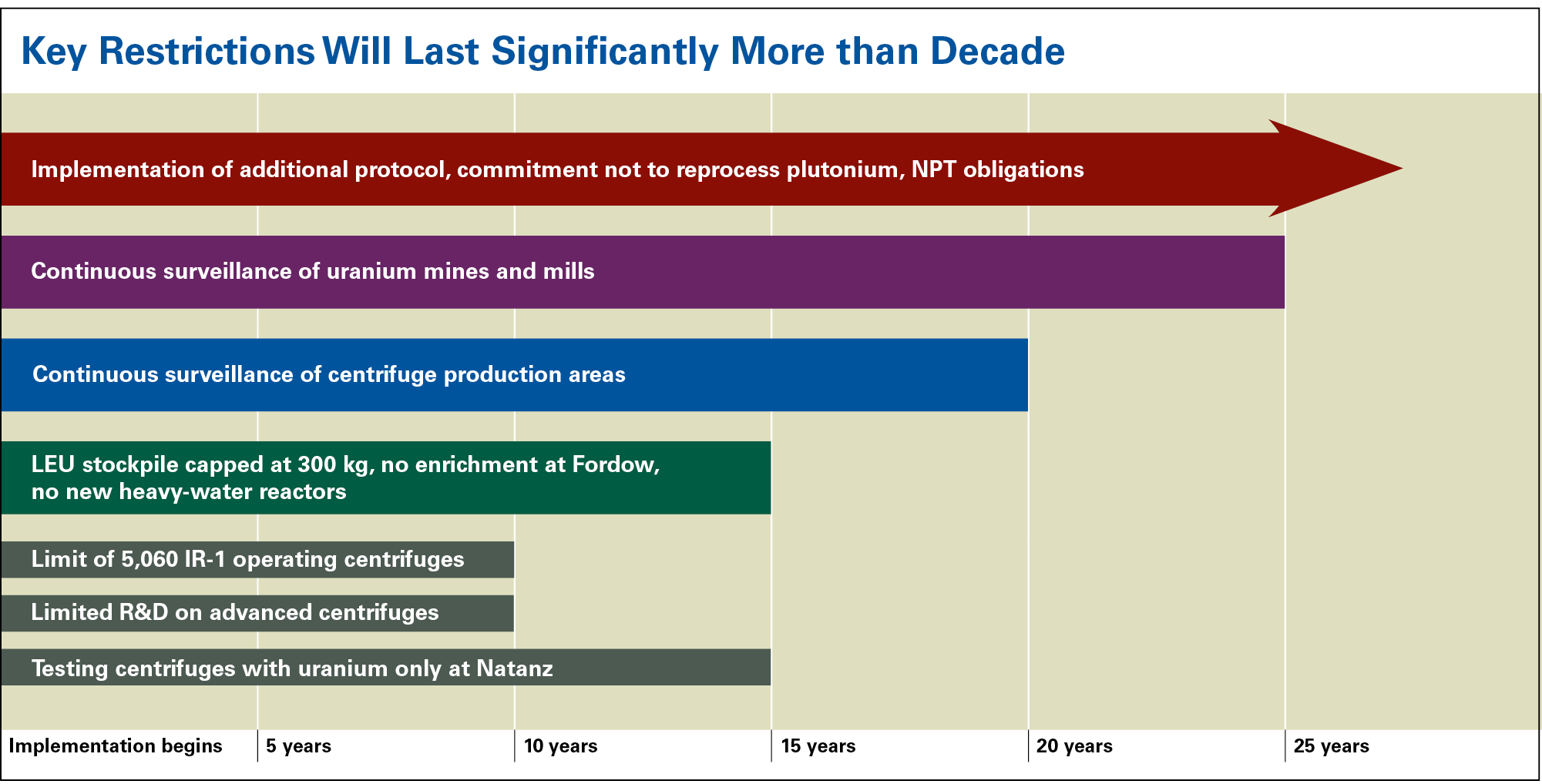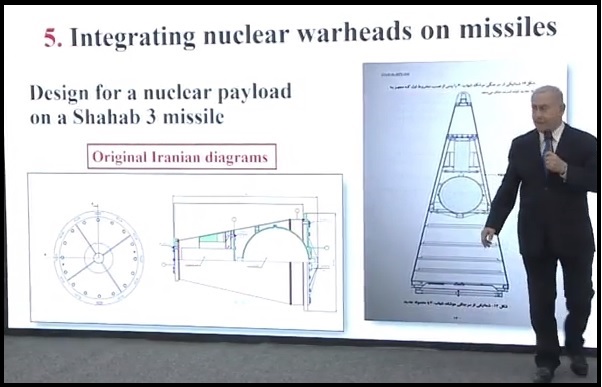For decades, the international community has grappled with the danger of nuclear weapons proliferation and, in particular, the risk that the Islamic Republic of Iran might seek the capability to design and produce nuclear weapons.
For more than a decade following the 2003 revelation that Iran had surreptitiously built a uranium conversion facility and an enrichment plant, the International Atomic Energy Agency (IAEA) and the world’s major powers have expended enormous effort and political capital to find ways through sanctions pressure and off-and-on diplomacy, to rein in Iran’s nuclear weapons potential.

In July 2015, after more than two years of sustained negotiations, the European Union, Germany, and the five permanent members of the U.N. Security Council concluded a detailed, 156-page agreement with Iran designed to block all its potential pathways to the bomb for some 10-15 years or more in exchange for significant sanctions relief.
Known as the Joint Comprehensive Plan of Action (JCPOA), the deal mandated significant, long-term, verifiable restrictions on Iran's enrichment facilities and research and development, and strict limits on its low-enriched uranium stockpile. These restrictions ensure that it would take Iran no less than 12 months to produce enough bomb-grade uranium sufficient for one weapon, and if it tried to do so, it would very likely be detected far sooner.
The JCPOA has also effectively eliminated Iran’s ability to produce and separate plutonium for a nuclear weapon for at least 15 years and commits Tehran to not reprocess spent fuel and to ship spent fuel out of the country.
The deal also put in place a multi-layered monitoring regime across Iran’s entire nuclear supply chain, including centrifuge manufacturing sites (for 20 years), uranium mining and milling (for 25 years), and continuous monitoring of many nuclear and nuclear-related sites. The JCPOA requires Iran to implement and ratify the Additional Protocol to the Nuclear Non-Proliferation Treaty, putting in place safeguards that necessitate early notification of design changes or new nuclear projects by Tehran.
Under the JCPOA’s terms, IAEA inspectors also have timely access to any Iranian facility of proliferation concern, including military sites, and IAEA access cannot be stalled more than 24 days without serious consequences.

Netanyahu on Iran’s Past Weapons Design Experiments
On April 30, Prime Minister Benjamin Netanyahu of Israel — which reportedly has its own unacknowledged nuclear weapons arsenal — laid out detailed documentation that he said provides evidence of Iran’s pre-2003 nuclear weapons design efforts. His arguments seemed intended to raise concerns about Iran’s future nuclear weapons ambitions and to build a case for scrapping the JCPOA — even though all parties, including the U.S. government, have agreed that Iran has met its commitments. His briefing was, however, a stark reminder of the JCPOA’s value.

Concerns about Iran’s nuclear weapons potential are not new. For more than a decade, the expert community, Western governments, and the IAEA have understood that Iranian scientists and technicians had conducted experiments with potential military dimensions – activities related to nuclear weapons design and development – prior to 2004.
In 2007, the United States released an unclassified summary of an updated National Intelligence Estimate on Iran’s nuclear program. It assessed “with high confidence” that Iran halted its nuclear weapons design and weaponization work and clandestine uranium conversion and enrichment in the fall of 2003. Additionally, it assessed with “moderate confidence” that the weapons program had not resumed as of mid-2007.
On November 8, 2011, the IAEA released a report detailing a range of activities related to nuclear weapons development, most of which occurred before 2004. It raised concerns that some weapons-related activities occurred after 2003. The information in the report was based primarily on information received from other countries, likely including Israel, but also included information from the agency’s own investigation.
Even if the documents assembled by Israel are genuine, they do not appear to reveal that prohibited nuclear weapons research and design activities continued in an organized fashion beyond 2003. Furthermore, contrary to Netanyahu’s assertion that Iran must “come clean” about its nuclear past, there is no such requirement for it to do so.
Instead, it is essential to ensure that Iran is no longer engaged in nuclear weapons research and design activities, that there is robust monitoring of Iran’s ongoing nuclear activities, and that Iran’s nuclear program is constrained in ways that prevent it from being able to quickly amass enough weapon-grade material for even one nuclear bomb.
One step in this multi-pronged strategy has already been undertaken. The IAEA conducted a detailed investigation into Iran’s activities with potential military dimensions beginning in 2013. Under the Joint Framework for Cooperation, Tehran agreed to take several steps to address IAEA concerns, including providing information and access to research reactors and production plants.
The 2013 Framework for Cooperation was superseded by the 2015 Roadmap for the Clarification of Past and Present Outstanding Issues regarding Iran’s Nuclear Program. The roadmap required Tehran to provide information on all the concerns the IAEA had identified in the 2011 report. Sanctions relief in the nuclear deal was contingent upon Iranian cooperation with the agency’s investigation.
The IAEA’s completed assessment, released on December 2, 2015, concluded that Iran had pursued an organized nuclear weapons research program prior to 2003, including a coordinated “range of activities relevant to the development of a nuclear explosive device.” Some activities continued through 2009, according to the report. But they “did not advance beyond feasibility and scientific studies, and the acquisition of certain relevant technical competences and capabilities.” The agency found “no credible indications” that nuclear material was diverted to the weapons program or that any undeclared activities had taken place since 2009.
Following a meeting on December 15, 2015, the 35-member IAEA Board of Governors voted unanimously to close the investigation into Iran's past weaponization work while continuing to report on Iran's implementation of the JCPOA.
The Value of the JCPOA
“The fact that Iran conducted sensitive research in secret until 2003 shows why we need the intrusive inspections allowed by the Iran nuclear deal today,” British Foreign Secretary Boris Johnson said in response to Netanyahu’s allegations. It is also why it is essential to keep the JCPOA restriction in place to ensure that Iran cannot amass enough fissile material necessary to build a nuclear weapon.
Netanyahu’s revelations came less than two weeks before the May 12 deadline for Trump to decide the fate of the JCPOA. “I’m sure he’ll do the right thing,” Netanyahu said at the end of his briefing. Trump has threatened to withdraw from the JCPOA if the so-called “sunset clauses,” as well as other issues outside the deal, such as Iran’s missile program and regional intervention, cannot be “fixed.”
If Trump fails to renew the sanctions waivers, he will risk deepening tensions between the United States and Iran, as well as tensions between the United States and the other parties to the JCPOA. Britain, China, France, Germany, Russia, and the European Union have all reiterated their support for the deal as long as Iran continues to meet its obligations.
Through April 2018, Iran had met its obligations under the JCPOA. The IAEA has reported Tehran’s compliance in 10 times. U.S. Secretary of State Mike Pompeo, testified to Congress in April that there was no evidence of Iranian noncompliance with the JCPOA.
Both Trump and Netanyahu have argued, however, that the JCPOA gives Iran a clear path to a nuclear weapon once some limits on its activities expire in 2025. “In seven years that deal will have expired and Iran is free to go ahead and create nuclear weapons. That’s not acceptable,” Trump said on April 30.
Experts disagree. This argument “discounts the value that the permanent monitoring mechanisms and prohibitions put in place by the deal have as a bulwark against nuclear weapons development,” wrote Kelsey Davenport, the Arms Control Association’s director for nonproliferation policy, in an issue brief.
Ironically, the United States will be in violation of its own commitments if Trump does not renew sanctions waivers on May 12. Without a viable alternative to the JCPOA in place, Trump could also face the danger of triggering another Middle East proliferation crisis. Strictly enforcing the deal and building on it would likely be a safer course of action.
There is nothing in the deal that prevents the United States and its European partners from pursuing a follow-on agreement with Iran that builds upon the JCPOA and reduces Tehran’s incentives to expand its nuclear program after certain nuclear restrictions expire down the road.
Daryl G. Kimball is the Executive Director of the Arms Control Association.
